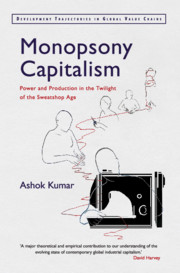Conclusion: The Twilight of the Sweatshop Age?
Published online by Cambridge University Press: 15 January 2020
Summary
The only constant is change.
– HeraclitusIn a course I teach on the dynamics of global capitalism, I begin with two sets of photos: garment and auto factories at the turn of the twentieth century and at the turn of the twenty-first. Students can see that the auto factory has undergone radical change, transforming the shop floor from a labour-intensive environment to one that is capital-intensive and reliant on advanced machinery. Robots now piece and fuse parts in an automated rhythm where previously workers had toiled by hand. The garment factory, however, looks much the same, with its rows of women hunched over sewing machines. While the demographics and pace may have changed, the factories, machinery, and value chain structure seem to exist outside of time, isolated from the developments that have transformed the rest of the global economy.
There's much that is striking about this pairing. First, autoworkers generally have higher union density now than garment workers and earn significantly higher wages because of it – despite all the assembly being done by robots. Second, it captures the sheer durability of the sweatshop within the garment sector. As I demonstrate in this book, the regulatory regime that had once enforced a degree of spatial inflexibility finally dwindled to nothing with the 2005 MFA phase-out. And the emergence of market spatial inflexibility, which gives labour new openings, can only occur if the flows between supplier and buyer are unrestricted. With this change, and a capable labour movement, there is hope yet that garment factory workers may close the gap.
A radical restructure of production
On 30 November 2018, the High Court of Bangladesh implemented a restraining order – passed days earlier – mandating the closure of the Dhaka office of the Accord for Fire and Building Safety (‘Accord’) and forcing its staff to leave the country. Introduced following the tragedy at Rana, the Accord had been heralded as an auditing regime finally capable of remedying the inhumane and often downright dangerous conditions that were endemic to Bangladesh's garment industry. However, the High Court's November restraining order, which pre-empted a negotiated 2021 Accord extension, was the result of concerns over inadequate government scrutiny.
- Type
- Chapter
- Information
- Monopsony CapitalismPower and Production in the Twilight of the Sweatshop Age, pp. 229 - 236Publisher: Cambridge University PressPrint publication year: 2020

